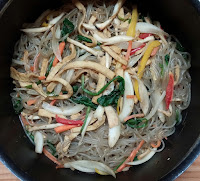Exploring the Rich Flavors and Time-Honored Traditions of Korean Cuisine
Introduction
A delicious fusion of flavors, textures, and colors that gracefully reflect the country's rich past and vibrant culture is what is known as Korean cuisine, or "hansik." Korean cuisine has gained widespread acclaim for its focus on fresh, healthy ingredients, balance, and an appealing presentation. From tasty BBQ foods to spicy stews and delicious fermented treats, let's go on a fascinating culinary journey that explores the varied and delicious world of Korean cuisine.
The Foundation of Korean Cuisine
At the heart of Korean cuisine is a strong belief in the importance of balance and harmony, both in the food itself and in how it can help people feel better all around. Based on Confucian values, Korean food culture puts a lot of emphasis on care for nature and the importance of eating together as a group. A traditional Korean lunch usually includes a bowl of hot rice, a warm bowl of soup, and a number of small side dishes called "banchan."
Key Ingredients and Flavors
The unique and interesting tastes of Korean cuisine come from the inventive use of traditional ingredients. Among these important parts are:
Rice is a main food that is eaten with most Korean meals. It is an important part of Korean cuisine. Rice is the base of many Korean dishes, from the common "bap" (cooked rice) to the tasty "bokkeumbap" (fried rice).
Gochujang is a bright red chili paste that is considered to be the soul of many Korean foods. It gives stews, sauces, and marinades a nice spicy kick and depth of flavor.
Kimchi: Kimchi is a well-known symbol of Korean cuisine and is loved by people all over the world. This popular food is made from fermented vegetables, mostly napa cabbage, and seasoned with a blend of spices, garlic, and ginger to give it a tangy and spicy taste that can't be mistaken.
Bulgogi is one of the most famous Korean BBQ meals. It is the star of the show. Thin slices of beef or pork that have been marinated are grilled to perfection and served with a mix of fresh veggies that go well with the main course.
Doenjang is a fermented soybean paste that is rich and savory. It is a staple in Korean cuisine and is often used as a base for soups and stews, giving the flavors more depth and complexity.
Sesame Oil: This nutty-smelling oil is often used to make foods taste better because it adds a delicious touch of umami.
Perilla Leaves: These soft leaves, which are called "kkaennip," are often used to wrap meat, rice, and other foods. They add a refreshing herbal taste to the dish.
Ganjang, which is also called Korean soy sauce, is one of the most important seasonings in Korean cooking. It adds saltiness and depth to a wide range of foods.
Popular Korean Dishes
Bibimbap, which means "mixed rice," is a meal that looks great and is full of healthy foods. Bibimbap is made up of colorful vegetables, thinly sliced meat, a perfectly fried egg, and gochujang, all of which are placed on a bed of rice. Before eating, the ingredients are usually mixed together to create a blend of tastes and textures.
Kimbap is a delicious snack that is sometimes called "Korean sushi." It is made of rice, a variety of vegetables, meat, or fish, and sometimes pickled radish, all wrapped in sheets of seaweed. Kimbap is a delicious snack that is easy to eat on the go. Both locals and tourists love it.
Jjigae: Korean stews, or jjigae, are comforting and come in a wide range of tastes. Kimchi jjigae is a popular version that blends the spicy, tangy taste of kimchi with tender pork, tofu, and other ingredients in a spicy, hearty broth. Sundubu jjigae is made with soft tofu, and doenjang jjigae is made with soy bean paste.
Samgyeopsal is another great part of Korean BBQ. It is made of thick pieces of tasty pork belly that have been grilled to perfection. This dish is fun and engaging to eat because it comes with garlic, lettuce leaves, and a variety of tasty dipping sauces.
Japchae is a sweet potato glass noodle dish that is stir-fried to perfection with a variety of colorful veggies, tender beef, and a savory soy sauce-based marinade. The result is a dish that is not only beautiful to look at but also a delight to eat.
Galbi: Korean short ribs, called galbi, are marinated in a sweet and spicy sauce and then grilled until they are done. Fans of BBQ must try the meat, which is juicy and full of flavor.
Tteokbokki is a famous street food that consists of chewy rice cakes cooked in a spicy gochujang sauce and often served with fish cakes and boiled eggs.
Conclusion
The flavors, historical roots, and sense of community are all wonderfully celebrated in Korean cuisine. Each dish tells a story through its unique combination of ingredients and careful way of making it, giving a glimpse into Korea's rich culinary history. Whether you find comfort in a steaming bowl of kimchi jjigae or enjoy the sizzling excitement of Korean BBQ, the depth and variety of Korean cuisine are sure to leave a lasting effect on your taste buds. Start this culinary adventure and enjoy the wonders of hansik. It will be a trip you'll never forget and that will please you deeply. From the bright colors and enticing smells to the perfect balance of flavors, Korean cuisine shows off the country's culinary skill and cultural pride. It invites food lovers to enjoy the time-honored traditions and culinary delights that make it a culinary gem. So, raise your chopsticks and raise a glass to the lasting legacy of Korean cuisine, where every bite is a celebration of the past, the present, and the bright future of one of the most loved culinary journeys in the world.










Comments
Post a Comment